Disclosure: Meeple Mountain received a free copy of this product in exchange for an honest, unbiased review. This review is not intended to be an endorsement.
I have no idea what’s going on in the industry. I’m not sure who or what started this trend, but I am seeing so many new games coming out that are trying to stuff different genres in our faces. Just the past few months alone, there are several games on the spotlight blending Deckbuilding and Worker Placement such as Dune: Imperium and Lost Ruins of Arnak. It seems to be a trend, and I’m still not sure how I feel about it.
What I wasn’t expecting in this latest craze is a game mixing card drafting, bluffing, and social deduction. That exists now, and it’s called Vigilante.
And you’ll need some vigilantes since there’s been a prison break. It ain’t your typical band of drug dealers, murderers, and bankers here. They have superpowers and don’t mind demonstrating their gifts to wreak havoc on the city.
There is hope, as there are some superpowered citizens, such as portal-wielding baristas and flying real estate agents, that want to help out. The problem is there isn’t a Xavier or Magneto to rally them, and that’s where you come in. You and your friends want to become leaders in this conflict, except some of you want the prisoners roaming around or have a selfish goal to fulfill.
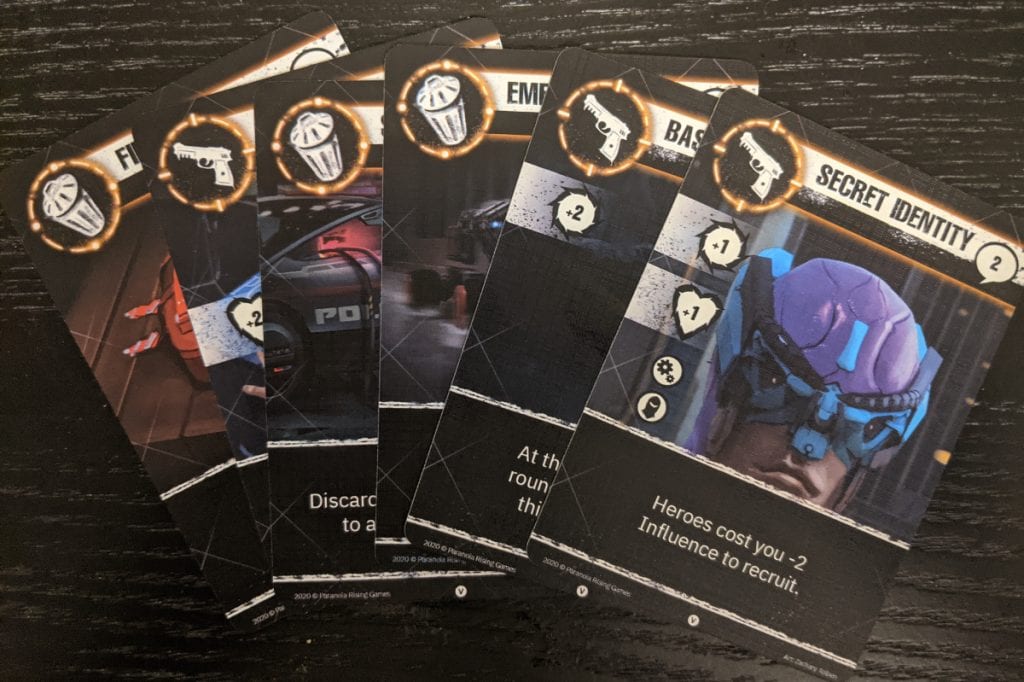
Assembling Your Team
Depending on the Scenario card, everyone will get an identity that will either tell them they are Guardian, Assassin, or a neutral character. The Guardians want to jail a certain number of villains at the end of the game while the Assassins want to prevent that. Neutral roles have a specific goal, and it can be anything from making sure everyone has at least one defeated hero to hoarding med packs. Like any other social deduction game, these identity cards are secret.
On your player mat, you’ll have four facedown Allegiance tokens, representing what team you are on and these tokens will be investigated by your curious yet doubtful friends. You will also get a random starting hero, put them on the 1 slot on your mat, and draw a handful of City cards. Done. More games need an easier setup.
Game flow is as straightforward as the setup and your goals. The Scenario card determines how many rounds are in the game, and each round is 4 actions. Beginning with the Start Player and going clockwise, everyone will do their actions one at a time. If a player ever finishes their turn with no actions remaining, they need to roll their dice behind their player shields and submit a die for the Events. I will explain that last bit later.
Getting The Right Costume
For the sake of your sanity and mine, I won’t go through a detailed rules outline because you can just read the rulebook for that. Most of the actions themselves are basic such as healing a hero, trading a card with another player, and drawing a card. The two main highlights are recruiting heroes and attacking the villains.
Recruiting heroes is similar to other deckbuilders with the usual random row of cards representing the market. Unlike other deckbuilders, there are no currency cards. Instead, each card in your hand has an “influence value,” and you must discard them to meet or exceed the influence value of the recruited hero. It’s not the most innovative mechanism out there, but it works.
When you recruit a hero, it has to go to the lowest-numbered slot, and if all four of your slots are full, you cannot recruit. This is vital to understand because villains will strike the lowered number slots more frequently than the higher numbered ones. Not only do you want a team with decent health, damage, and abilities, you are also concerned about the order you’ve recruited them. Since this is a drafting game, other players will likely seize your desired hero, making timing a crucial element to your success.
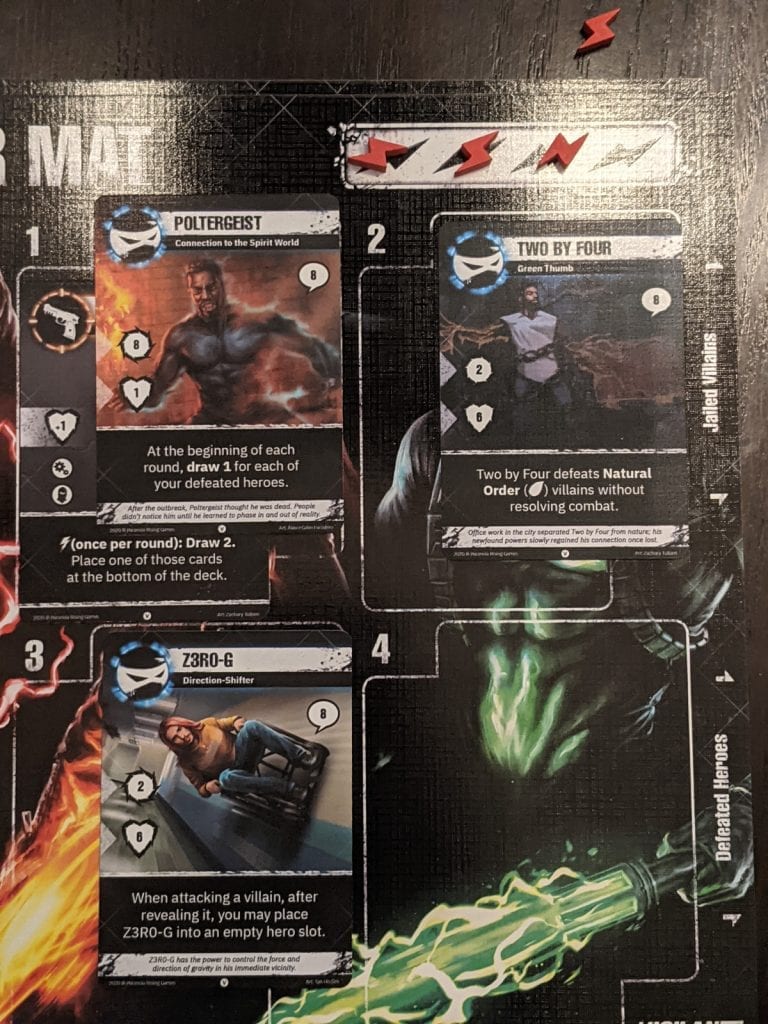
The Ultimate Showdown
You aren’t assembling your team without a purpose. This is about defeating villains, and you can spend an action point to do exactly that. The villain deck has villains from levels 1 to 3, and you flip the top card of the villain deck and deal with the results. It shows you the numbered slots the villain will attack, its health, and any special abilities that trigger. If your team’s attack number is at least equal to the villain’s health, you add the villain to your jail stash. If not, the villain goes to the bottom of the deck. It’s quick and easy to understand.
Honestly, that would be an excellent way to describe the flow of this game. It’s not a hard game to grasp, even for the newest board gamers, since it only takes a sentence or two to explain most of the actions. It also helps that the player screen has most of the necessary information to play. The only missing details are some of the “free actions” you take before doing your main action, and the three icons denoting the three card types in the game.
For those concerned about blind drawing from the villain deck because of “luck,” the player screen also gives you information to work with. While the player screen does not disclose the damage ranges, it will show you the health ranges for each level, so any failure to defeat the villain is mainly your fault.
Mandatory Plot Twists
With all of this out of the way, I can finally talk about the Events. At the start of each game, there will be a few Event tiles placed on the main board, and every round begins with the starting player picking one Event tile of the two drawn from the bag. These events are, pardon the pun, a mixed bag. Some are favorable such as allowing everyone to draw a card, while some are mean, like forcing everyone to free a villain due to yet another jailbreak.
Activating Event tiles is a whole different affair. Each tile is associated with a die result. At the end of a turn where you have no more actions left, you must roll two dice behind your shield and submit one to the event pool. Any Event tiles that match a submitted die will activate at the end of the round. You can also submit a die that matches nothing. I’m sure some of you are getting Dark Moon vibes from this.
Come to think of it, there are a lot of vibes here. You have the drafting gameplay similar to deckbuilders like Ascension. Organizing your team with their persistent rule-breaking abilities feels like a tableau builder. Playing cards from your hand to mess with your opponents is old school Magic the Gathering. You can even attach equipment cards to your heroes to give them new abilities, and for some reason, one of them is a cat.
It’s tempting to say that this sounds like some aberration of mechanisms that should not be, but it works. All of these ingredients create this aroma that I can’t compare to any other game. No matter what your role is, you will do the same thing as everyone else. You are going to draft cards, play cards, and jail villains. It’s just your intentions that will conflict with others.
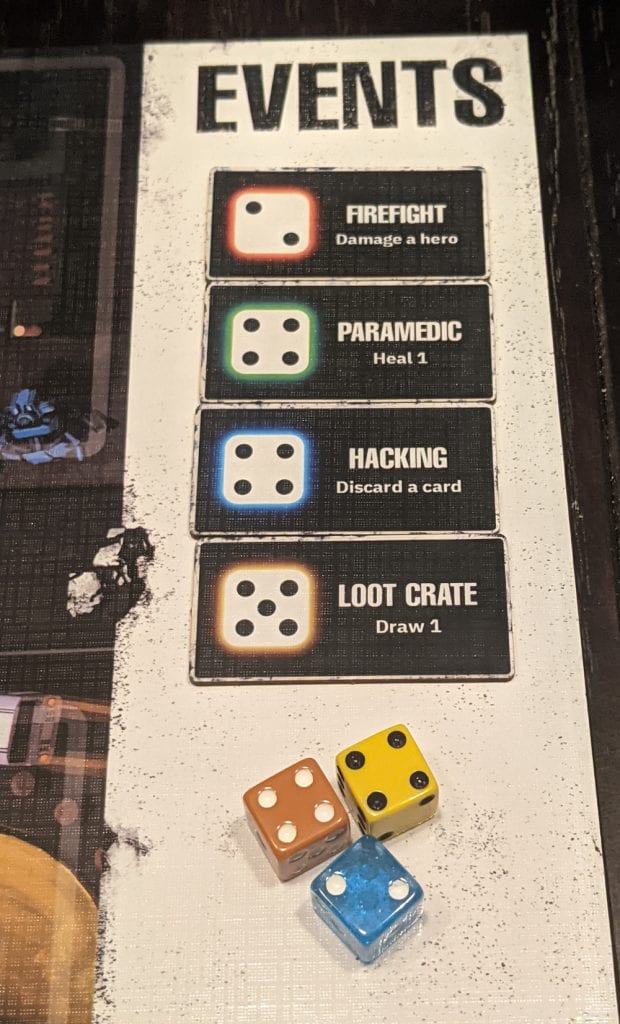
Putting On The Mask
To illustrate this point, let me explain a typical four-player basic scenario. There are two Guardians, one Assassin, and one random Neutral player.
For the two Guardians to win, they need to jail at least 14 villains since it’s 7 per Guardian in the game. It doesn’t matter which Guardian does it, as long as there are 14 altogether by the end. Any villains jailed by the Assassin or Neutral do not count towards this goal.
Immediately you begin to see the cracks here. From the very first turn, everyone rushes to draft the available heroes to start jailing some villains. After all, these villains are only level 1, so this is the most prime time to do it. Guardians want to grab a few easy ones, the Assassin wants to drain the Villain pool until it hits Level 2, and the Neutral does need some Villains to fill whatever chaotic agenda they have.
As the players plow through the deck, the consequences become direr with stronger and stronger villains. Besides increased damage numbers, villains have potent effects that will endanger your dream team in a flash. Recuperating from a fight takes longer, something you can’t afford in a game with limited rounds, thereby forcing you to cooperate with others.
Hide And Seek With Words
It is here where the social deduction portion kicks down the door and makes its presence known with a booming roar.
One of the typical stereotypes of the social deduction genre is exclusive rules. Some games, like Werewolf, give certain players privileges such as the ability to kill a villager during the night. That idea does not apply here.
Anything you can do to others, they can do it to you. The only difference between you and your friends is your endgame goal. To intensify the situation, the game’s entire structure is designed around aggressive play.
One example of this is a particular rule regarding defeated heroes. If you ever have three defeated heroes, you cannot submit an event die at the end of the round, denying you the ability to manipulate the situation to your favor.
Due to these constraints, this puts the non-Guardian players in an awkward position. They have to blend with their surroundings because sticking out as the outlier of the group will make them a target of hostile card plays. They must either take advantage of the social environment to go after one player or backstab when there isn’t a good opportunity to counterplay. It’s this “meta” that makes me love the social layer of this game.
Setting The Trap
However, there are numerous ways the “bad” team can poke holes like a vindictive journalist. As an action, you can trade a card with another player, but this trade is facedown, giving you a moment to lie. If you are the Start Player, you have the opportunity to place an unfavorable Event tile while trying your best to persuade your friends that the other option was far worse. Some cards allow you to look at another player’s allegiance token, which is yet another opportunity to lie. Even though you cannot attack your opponent’s heroes freely, some cards allow you to deal damage to your friend’s heroes.
I will admit that this is something you will likely not experience in the first or second playthrough. This is a very unorthodox game and players will likely perform moves that they shouldn’t be doing yet will still judge based on their unoptimized play. It’s an unfair way to evaluate a game, but it does happen.
One of the major complaints I often hear from new players is the Investigation mechanism. Whenever a card tells you to Investigate another player, you will look at one of their four face down Allegiance tokens in secret. Two of those tokens will match the team they are on. There is nothing wrong with this mechanism by itself, but it’s just the opportunity to use it strictly based on a card draw. In other words, they feel there isn’t much information to go on.
I disagree with this assessment. Giving so much concrete information to the players where they know everyone’s roles means the card play becomes obvious, leading to a very boring experience. Much like threatening grey clouds on a wedding day, it’s the ambiguity that solidifies the tension. It’s far better to deduce the players based on their actions such as their cards, event tiles, or the event die. The Investigation mechanism is to provide some tangible evidence for the players to chew on, not to be the solution to this puzzle.
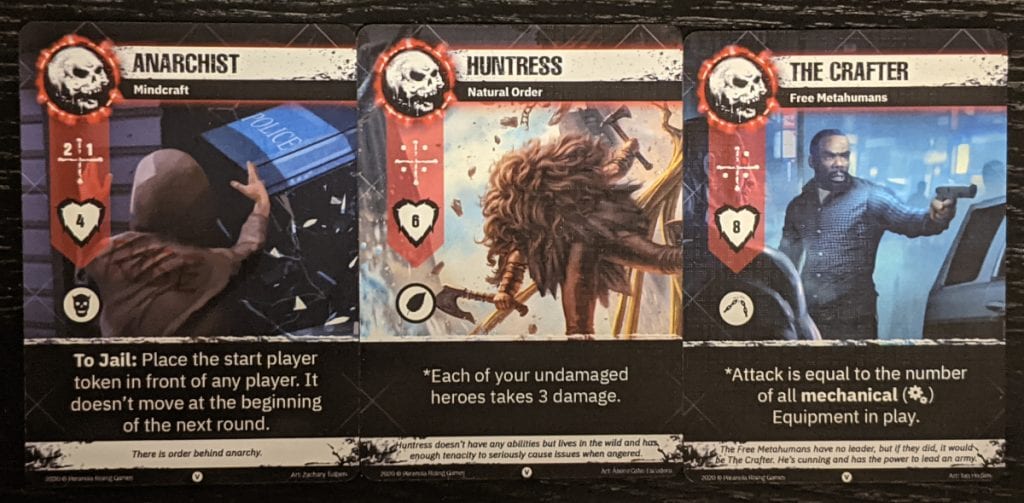
Noticeable Scars
Like any other social deduction game, player scaling is critical. The majority of my games were three players, although I have tested this game out with five players. It is doable with three players, but you are missing out on the neutral roles if you go that route. My personal favorite is four players since it throws in an Assassin and Neutral role into the mix. Five player games do work, yet I have to give a warning about downtime. There are several scenarios for different player counts, such as 2 vs 2 team mode and all-random identities, so replayability isn’t an issue. I would even go so far as to say this is one of the few games that doesn’t need an expansion.
There is one concern, but it doesn’t deter my enthusiasm. The idea of neutral roles designed to muddy the situation is expected and welcomed, yet some of the goals feel a bit off. One of the ones that stuck out is the Worshipper of Life. Their goal is to jail 4 villains, have at least 3 alive heroes, and no damage on them at the end of the game. My problem with this role is it’s easy to blend in as a Guardian, so your concerns are to make sure you aren’t a target of an Assassin, a hostile Neutral player, or the “firefight” event tile. Compared to the other Neutral roles, which there are about 7 of them, this one feels too simplistic. I prefer the goals that force me to think of a plan to mess with everyone.
That’s a minor issue though. Vigilante is one of the few unique games that manages to mix several familiar mechanisms of old and spins it into a new direction. I’ll admit that I have my bias towards drafting and social deduction, but my passion does not mean endless praise. I have no issue nitpicking a game that I firmly believe isn’t worth your time or mine. My review style has always been to build up the game first, try to knock it down, and see if it still stands. Right now, Vigilante is still standing.
You can check out the Kickstarter Campaign here





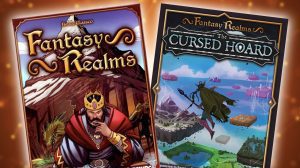

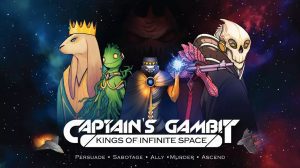




Thanks for the excellent overview of the game, Mark!
I’ve already made changes based on your feedback to the screen, and will definitely look into other feedback.